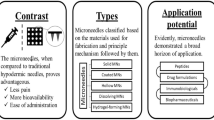Abstract
The association of microneedles with electric pulses causing electroporation could result in an efficient and less painful delivery of drugs and DNA into the skin. Hollow conductive microneedles were used for (1) needle-free intradermal injection and (2) electric pulse application in order to achieve electric field in the superficial layers of the skin sufficient for electroporation. Microneedle array was used in combination with a vibratory inserter to disrupt the stratum corneum, thus piercing the skin. Effective injection of proteins into the skin was achieved, resulting in an immune response directed to the model antigen ovalbumin. However, when used both as microneedles to inject and as electrodes to apply the electric pulses, the setup showed several limitations for DNA electrotransfer. This could be due to the distribution of the electric field in the skin as shown by numerical calculations and/or the low dose of DNA injected. Further investigation of these parameters is needed in order to optimize minimally invasive DNA electrotransfer in the skin.







Similar content being viewed by others
References
André FM, Gehl J, Sersa G et al (2008) Efficiency of high- and low-voltage pulse combinations for gene electrotransfer in muscle, liver, tumor, and skin. Hum Gene Ther 19:1261–1271
Bal SM, Caussin J, Pavel S et al (2008) In vivo assessment of safety of microneedle arrays in human skin. Eur J Pharm Sci 35:193–202
Bodles-Brakhop AM, Heller R, Draghia-Akli R (2009) Electroporation for the delivery of DNA-based vaccines and immunotherapeutics: current clinical developments. Mol Ther 17:585–592
Chabri F, Bouris K, Jones T et al (2004) Microfabricated silicon microneedles for nonviral cutaneous gene delivery. Br J Dermatol 150:869–877
Dujardin N, Staes E, Kalia Y et al (2002) In vivo assessment of skin electroporation using square wave pulses. J Control Release 79:219–227
Gill HS, Prausnitz MR (2007) Coated microneedles for transdermal delivery. J Control Release 117:227–237
Henry S, McAllister DV, Allen MG et al (1998) Microfabricated microneedles: a novel approach to transdermal drug delivery. J Pharm Sci 87:922–925
Hoel A, Baron N, Cabodevila G et al (2008) Microfluidic distribution system for an array of hollow microneedles. J Micromech Microeng 18:065019
Hooper JW, Golden JW, Ferro AM, King AD (2007) Smallpox DNA vaccine delivered by novel skin electroporation device protects mice against intranasal poxvirus challenge. Vaccine 25:1814–1823
Kaushik S, Hord AH, Denson DD et al (2001) Lack of pain associated with microfabricated microneedles. Anesth Analg 92:502–504
Kolli CS, Banga AK (2008) Characterization of solid maltose microneedles and their use for transdermal delivery. Pharm Res 25:104–113
Lackovic I, Magjarevic R, Miklavcic D (2009) Three-dimensional finite-element analysis of joule heating in electrochemotherapy and in vivo gene electrotransfer. IEEE Trans Dielec Elec Insul 16:1338–1347
Lin W, Cormier M, Samiee A et al (2001) Transdermal delivery of antisense oligonucleotides with microprojection patch (Macroflux) technology. Pharm Res 18:1789–1793
Martanto W, Davis SP, Holiday NR et al (2004) Transdermal delivery of insulin using microneedles in vivo. Pharm Res 21:947–952
Miklavcic D, Pucihar G, Pavlovec M et al (2005) The effect of high frequency electric pulses on muscle contractions and antitumor efficiency in vivo for a potential use in clinical electrochemotherapy. Bioelectrochemistry 65:121–128
Mir LM (2009) Nucleic acids electrotransfer-based gene therapy (electrogenetherapy): past, current, and future. Mol Biotechnol 43:167–176
Oh JH, Park HH, Do KY et al (2008) Influence of the delivery systems using a microneedle array on the permeation of a hydrophilic molecule, calcein. Eur J Pharm Biopharm 69:1040–1045
Park JH, Allen MG, Prausnitz MR (2005) Biodegradable polymer microneedles: fabrication, mechanics and transdermal drug delivery. J Control Release 104:51–66
Pavselj N, Miklavcic D (2008) Numerical modeling in electroporation-based biomedical applications. Radiol Oncol 42:159–168
Pavselj N, Préat V (2005) DNA electrotransfer into the skin using a combination of one high- and one low-voltage pulse. J Control Release 106:407–415
Pavselj N, Préat V, Miklavcic D (2007) A numerical model of skin electropermeabilization based on in vivo experiments. Ann Biomed Eng 35:2138–2144
Prausnitz MR (2004) Microneedles for transdermal drug delivery. Adv Drug Delivery Rev 56:581–587
Prausnitz MR, Langer R (2008) Transdermal drug delivery. Nat Biotechnol 26:1261–1268
Roxhed N, Griss P, Stemme G (2008) Membrane-sealed hollow microneedles and related administration schemes for transdermal drug delivery. Biomed Microdevices 10:271–279
Sivamani RK, Stoeber B, Liepmann D et al (2009) Microneedle penetration and injection past the stratum corneum in humans. J Dermatol Treat 20:156–159
Vandermeulen G, Staes E, Vanderhaeghen ML et al (2007) Optimisation of intradermal DNA electrotransfer for immunization. J Control Release 124:81–87
Vandermeulen G, Daugimont L, Préat V (2008) DNA transfer in the skin. In: Walters KA, Roberts MS (eds) Dermatologic, cosmeceutic and cosmetic development: therapeutic and novel approaches. Informa Healthcare, New York, pp 537–555
Vandermeulen G, Daugimont L, Richiardi H et al (2009) Effect of tape stripping and adjuvants on immune response after intradermal DNA electroporation. Pharm Res 26:1745–1751
Vemulapalli V, Yang Y, Friden PM et al (2008) Synergistic effect of iontophoresis and soluble microneedles for transdermal delivery of methotrexate. J Pharm Pharmacol 60:27–33
Verbaan FJ, Bal SM, van den Berg DJ et al (2008) Improved piercing of microneedle arrays in dermatomed human skin by an impact insertion method. J Control Release 128:80–88
Wang PM, Cornwell M, Hill J et al (2006) Precise microinjection into skin using hollow microneedles. J Invest Dermatol 126:1080–1087
Whitesides GM, Xia Y (1998) Soft lithography. Annu Rev Mater Sci 28:153–184
Acknowledgments
Are addressed to the UE sixth framework program and the Angioskin consortium (LSH-2003-512127) that made this work possible.
Author information
Authors and Affiliations
Corresponding author
Additional information
The first two authors contributed equally to this work.
Rights and permissions
About this article
Cite this article
Daugimont, L., Baron, N., Vandermeulen, G. et al. Hollow Microneedle Arrays for Intradermal Drug Delivery and DNA Electroporation. J Membrane Biol 236, 117–125 (2010). https://doi.org/10.1007/s00232-010-9283-0
Received:
Accepted:
Published:
Issue Date:
DOI: https://doi.org/10.1007/s00232-010-9283-0




